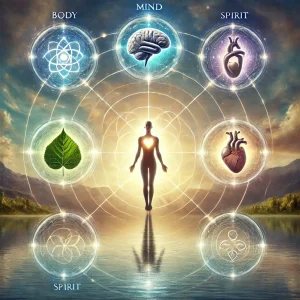 In the realm of psychedelic integration, the Holistic Model for a Balanced Life by Francoise Bourzat and Kristina Hunter (2019) stands out as a deeply comprehensive and grounded approach. This model draws from both Indigenous traditions and contemporary therapeutic practices, offering a framework that promotes balance across multiple dimensions of life.
In the realm of psychedelic integration, the Holistic Model for a Balanced Life by Francoise Bourzat and Kristina Hunter (2019) stands out as a deeply comprehensive and grounded approach. This model draws from both Indigenous traditions and contemporary therapeutic practices, offering a framework that promotes balance across multiple dimensions of life.
By focusing on body, mind, spirit, community, and nature, Bourzat and Hunter provide a blueprint for integrating the profound insights and experiences gained during psychedelic journeys in a way that promotes lasting transformation and well-being.
The Core of the Holistic Model for a Balanced Life
The Holistic Model for a Balanced Life emphasizes that psychedelics have the potential to catalyze deep personal growth and healing, but these experiences need to be integrated into daily life for their benefits to be fully realized. Unlike more narrow approaches that focus primarily on the psychological or spiritual aspects of integration, this model takes a whole-person approach, addressing multiple interconnected domains of life.
At the heart of this model is the belief that a balanced and integrated life is one where all aspects of the self are nurtured and aligned. The model identifies five key domains that must be considered and balanced:
- Body
- Mind
- Spirit
- Community
- Nature
Let’s explore each of these domains in detail to understand how they contribute to the overall process of psychedelic integration and a balanced life.
1. The Body: Grounding Through Physical Awareness
In many Indigenous traditions, the body is seen as an essential vessel for wisdom and healing. Bourzat and Hunter emphasize that the physical body plays a crucial role in psychedelic integration. After an intense psychedelic experience, the body can serve as an anchor to help ground the individual in the present moment.
This domain of the model encourages individuals to practice body awareness through somatic practices such as yoga, breathwork, dance, or body-centered therapies. Engaging in regular physical activity, proper nutrition, and self-care routines can help integrate the emotional and spiritual insights gained during psychedelic experiences. The body, in this sense, becomes a source of grounding, balance, and healing.
2. The Mind: Harnessing Insights for Personal Growth
The mind is another central domain in the Holistic Model for a Balanced Life. Psychedelic experiences often lead to profound realizations, uncovering repressed emotions, traumas, or hidden parts of the psyche. However, the mind must be engaged in the process of meaning making to fully integrate these experiences.
Bourzat and Hunter suggest that individuals practice introspection and reflection to process and understand the insights from their journeys. Journaling, therapy, and meditative practices can help individuals connect their newfound realizations to their everyday lives, fostering personal growth. The mind, when actively engaged in the integration process, helps create a clear framework for making lasting changes.
3. Spirit: Deepening the Connection to Something Greater
In the Holistic Model for a Balanced Life, spirituality plays a central role in integration. Psychedelic experiences often evoke a deep sense of connection to a higher power, the universe, or the inner self. Bourzat and Hunter acknowledge that spirituality can take many forms, whether rooted in a specific religious tradition, a personal belief system, or a more universal connection to nature and the cosmos.
The model encourages individuals to cultivate a regular spiritual practice that aligns with their beliefs and experiences. This could include meditation, prayer, mindfulness, or participating in spiritual communities. By continuing to engage in practices that deepen their connection to something greater than themselves, individuals can maintain the sense of meaning and purpose that psychedelics often bring to light.
4. Community: Finding Support and Connection
Human beings are inherently social creatures, and community is an essential domain in this model. Bourzat and Hunter emphasize the importance of building and maintaining strong, supportive relationships as part of the integration process. Psychedelic experiences often illuminate the importance of interpersonal connections, empathy, and compassion.
This model encourages individuals to engage with their social networks, whether through support groups, integration circles, or simply fostering deeper connections with friends and family. By sharing their experiences with others, individuals can feel a sense of belonging and validation, making it easier to navigate the often complex emotional and spiritual terrain that follows a psychedelic journey.
In many Indigenous traditions, the community plays a central role in rituals and ceremonies involving plant medicine. Bourzat and Hunter draw on this wisdom, suggesting that modern individuals also benefit from having a community-based approach to integration.
5. Nature: Reconnecting with the Earth
The natural world is a key element in this model, drawing on Indigenous traditions that view nature as a source of wisdom, healing, and balance. Bourzat and Hunter emphasize that spending time in nature can help individuals reconnect with themselves, the earth, and the universe.
The psychedelic experience often fosters a heightened sense of interconnectedness, and engaging with nature can help ground these feelings into daily life. Whether through spending time in forests, practicing gardening, or simply meditating outdoors, reconnecting with nature can help individuals align themselves with the cycles of life and the organic flow of the universe.
The Process of Integration
In addition to the five domains, Bourzat and Hunter outline a three-part process for psychedelic integration: Return, Understand, and Implement.
- Return: After the psychedelic experience, individuals return to their regular lives, but they carry with them the insights, emotions, and revelations from the journey.
- Understand: The second phase involves reflecting on and understanding the experience. Individuals must make sense of the emotions, symbols, and lessons that arose during their journey, linking these insights to their personal lives.
- Implement: The final phase of the process involves taking concrete actions to implement the lessons from the experience into daily life. Whether this means changing habits, strengthening relationships, or committing to personal growth, the goal is to bring the transformative power of psychedelics into the practical world.
Why the Holistic Model Matters
The Holistic Model for a Balanced Life stands out for its comprehensive, whole-person approach. It recognizes that true integration does not happen in isolation—it must involve the body, mind, spirit, community, and nature. By addressing these interconnected domains, individuals are able to achieve a state of balance and harmony that allows for long-lasting personal transformation.
This model is especially important today as psychedelics gain popularity not just for therapeutic use but for personal and spiritual growth. Many individuals are turning to psychedelics to heal trauma, overcome emotional struggles, or deepen their connection to the world around them. However, without proper integration, these experiences can feel disorienting or incomplete. Bourzat and Hunter’s model provides a clear, structured path forward, ensuring that individuals can fully embrace the lessons of their journeys and apply them to create meaningful change.
Conclusion
The Holistic Model for a Balanced Life by Bourzat and Hunter offers a deeply integrated and well-rounded approach to psychedelic integration. By focusing on balancing the body, mind, spirit, community, and nature, this model helps individuals align all aspects of their life with the wisdom gained from their psychedelic journeys. The model’s emphasis on personal growth, social connection, and ecological awareness makes it a powerful tool for those seeking to transform their lives through the integration of psychedelic experiences.
In a world that often feels fragmented and disconnected, this holistic approach reminds us that true healing and transformation come from balancing every part of ourselves—from our physical well-being to our spiritual fulfillment, from our relationships with others to our relationship with the earth.




